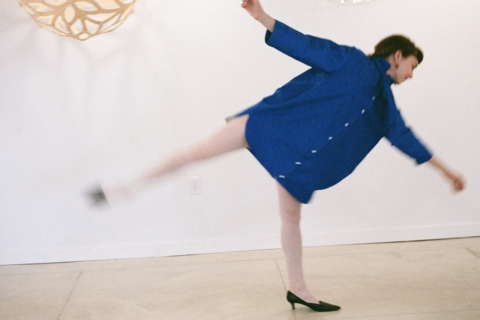Why Tony Chestnut’s Designer is Choosing to Stay Positive
Designer Jill Sawatzky will release her new collection over the coming weeks.
“I love the idea of making art in spite of the circumstances,” says Tony Chestnut founder Jill Sawatzky. Based in Winnipeg, the designer is about to launch a new collection of versatile voluminous dresses and separates that are heavily inspired by movies and documentaries she watched about Russian ballet dancers. Sawatzky highlights the difficulties these and other creatives have faced, from political to economic, yet they still kept going in pursuit of their life’s work. “That’s a bit of what we’re in right now, isn’t it,” she muses.
The freedom of movement afforded by her designs is one through-line in Sawatzky’s collections; another is freedom of expression. “Androgyny is a common thread through the collections,” she says. “I don’t think I make women’s clothing—I just make clothing and whoever wants to wear it can party on.”
That aspect of openness is captured by the brand’s name as well, which derives from a childhood action song Sawatzky learned at camp. “I like that it’s a man’s name,” she notes about lending a certain ambiguity to her work, adding that the ‘chestnut’ also speaks to her use of natural fibres like woven cotton. And here Sawatzky points to her Mennonite heritage as another influence. “I’m very inspired by the idea of living off the land and sustainability-at-large.”
It was Sawatzky’s grandmother who taught her how to knit as a teenager—a skill she put back to use last year in the midst of “an anxious time. I felt like I needed to do something with my hands that didn’t feel like work,” she says. But what started as a way to relax turned into another element of the Tony Chestnut brand; Sawatzky occasionally offers a range of one-of-a-kind knitwear on her website, all crafted from leftover bits of yarn she has sourced from other knitters in her community. The idea came from the rags her grandmother would create using her own ends of yarn. “Instead of getting rid of them, she kept them [and] would take the scraps and make rags.,” Sawatzky recalls. “I remember thinking those were the prettiest things that she made. They were just chaos—all these colours and textures.”
What her grandmother considered practical and necessary is now branded as ‘upcycling’ in today’s fashion community, and it’s one way designers are approaching a more thoughtful means of production. And in light of COVID-19 and the “hard reset” brands are currently confronted by, Sawatzky is facing the future with an optimistic outlook. “I think that it will only mean good things for our industry,” she says, adding that for creatives it means an opportunity to “come up with a different rhythm and structure” to their business. And when you dance to your own beat the way Sawatzky does, that can only mean great things to come.








